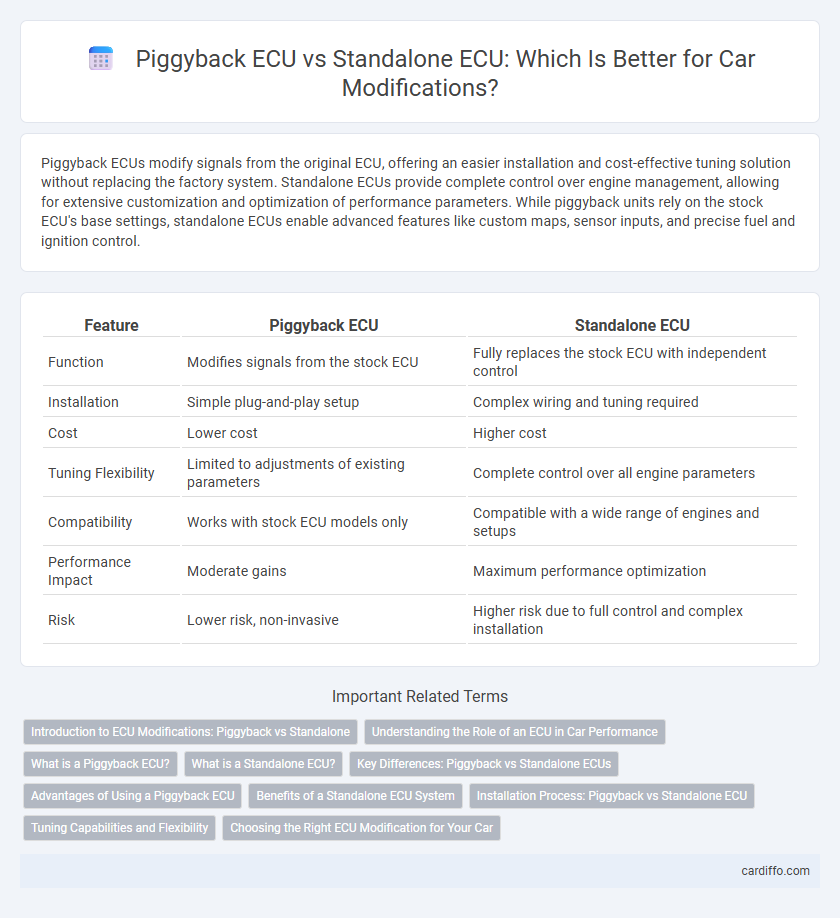Piggyback ECUs modify signals from the original ECU, offering an easier installation and cost-effective tuning solution without replacing the factory system. Standalone ECUs provide complete control over engine management, allowing for extensive customization and optimization of performance parameters. While piggyback units rely on the stock ECU's base settings, standalone ECUs enable advanced features like custom maps, sensor inputs, and precise fuel and ignition control.
Table of Comparison
| Feature | Piggyback ECU | Standalone ECU |
|---|---|---|
| Function | Modifies signals from the stock ECU | Fully replaces the stock ECU with independent control |
| Installation | Simple plug-and-play setup | Complex wiring and tuning required |
| Cost | Lower cost | Higher cost |
| Tuning Flexibility | Limited to adjustments of existing parameters | Complete control over all engine parameters |
| Compatibility | Works with stock ECU models only | Compatible with a wide range of engines and setups |
| Performance Impact | Moderate gains | Maximum performance optimization |
| Risk | Lower risk, non-invasive | Higher risk due to full control and complex installation |
Introduction to ECU Modifications: Piggyback vs Standalone
Piggyback ECUs modify sensor signals from the original ECU to alter engine parameters without complete control, offering a cost-effective and reversible tuning solution. Standalone ECUs replace the factory unit entirely, providing full access to engine management, including fuel maps, ignition timing, and boost control, ideal for extensive modifications. Choosing between piggyback and standalone ECUs depends on the desired level of customization, complexity of the build, and budget constraints.
Understanding the Role of an ECU in Car Performance
A piggyback ECU modifies signals from the original engine control unit to enhance car performance without replacing the factory system, allowing for easier tuning and reversibility. In contrast, a standalone ECU offers complete control over engine parameters, enabling extensive customization and optimization for high-performance applications. Both solutions impact fuel injection, ignition timing, and boost control, but standalone ECUs provide greater flexibility for advanced modifications.
What is a Piggyback ECU?
A Piggyback ECU is an aftermarket engine control unit designed to modify sensor signals between the factory ECU and the engine, allowing performance tuning without replacing the original ECU. It intercepts or alters inputs such as throttle position, air-fuel ratio, and ignition timing to optimize engine performance while retaining factory safety features. This modification offers a cost-effective and reversible solution for enhancing vehicle power compared to a standalone ECU system.
What is a Standalone ECU?
A standalone ECU (Engine Control Unit) is an independent control system designed to fully manage engine functions without relying on the factory ECU. It controls fuel injection, ignition timing, and other critical engine parameters, allowing complete customization and tuning for performance or efficiency. Unlike piggyback ECUs, standalone units replace the original ECU entirely, offering greater flexibility and precision for engine modifications.
Key Differences: Piggyback vs Standalone ECUs
Piggyback ECUs modify signals between the factory ECU and engine components, offering cost-effective tuning without replacing the original ECU, while standalone ECUs completely replace the factory unit, providing full control over engine parameters and advanced customization capabilities. Piggyback systems are simpler to install and maintain but limited in tuning scope, whereas standalone ECUs require complex installation and calibration but enable comprehensive engine management including fuel, ignition, and boost control. Key differences include the level of control, installation complexity, and tuning flexibility, making standalone ECUs preferable for high-performance applications requiring precise engine optimization.
Advantages of Using a Piggyback ECU
Piggyback ECUs offer the advantage of simpler installation and lower cost compared to standalone ECUs, as they modify existing signals without fully replacing the factory control unit. They allow for targeted tuning adjustments, enhancing specific performance parameters while retaining factory safety features and compatibility. This approach minimizes risk of system failure and preserves vehicle diagnostics, making piggyback ECUs ideal for incremental performance improvements.
Benefits of a Standalone ECU System
A standalone ECU system offers comprehensive control over engine functions, enabling precise tuning and optimization for enhanced performance and fuel efficiency. It supports advanced features like data logging, multiple sensor inputs, and customizable maps, which piggyback ECUs often cannot fully manage. Standalone ECUs also reduce dependency on factory engine management, providing greater flexibility for modifications and better compatibility with custom hardware setups.
Installation Process: Piggyback vs Standalone ECU
Piggyback ECU installation typically involves tapping into existing wiring harnesses, making it less invasive and quicker to set up compared to standalone ECUs, which require complete removal and replacement of the factory ECU. Standalone ECU installations necessitate extensive wiring, custom tuning, and integration with sensors to fully control engine parameters for optimal performance. While piggyback ECUs offer a simpler plug-and-play modification with fewer changes, standalone ECUs provide comprehensive control at the cost of a more complex and time-consuming installation process.
Tuning Capabilities and Flexibility
Piggyback ECUs offer limited tuning capabilities by intercepting sensor signals and adjusting parameters primarily within predefined ranges, making them suitable for minor performance enhancements without extensive engine management changes. Standalone ECUs provide complete tuning flexibility with direct control over fuel injection, ignition timing, boost levels, and advanced engine parameters, enabling comprehensive customization for a wide array of engine types and performance goals. The standalone approach supports extensive data logging, sensor integration, and real-time adjustments, essential for professional tuning and high-performance applications.
Choosing the Right ECU Modification for Your Car
Selecting the right ECU modification depends on your car's specific performance goals and budget constraints. Piggyback ECUs offer a cost-effective solution by intercepting and adjusting sensor signals without replacing the factory ECU, ideal for mild tuning and maintaining factory reliability. Standalone ECUs provide full control over engine parameters, allowing extensive customization and improved performance, but require more investment and technical expertise for proper calibration.
piggyback ECU vs standalone ECU Infographic

 cardiffo.com
cardiffo.com